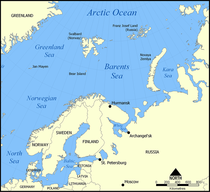Barents Sea

The Barents Sea, An Integral Part of the Artic Ocean
Directly north of Russia and Norway lies the Barents Sea. Part of the Artic Ocean, the temperatures dip below freezing in the winter months. However, in the southern half of the sea, the water never freezes due to the North Atlantic drift. This sea is considered to be a very deep shelf sea. The average depths of the Barents Sea lies between 760 feet to 1,480 feet. The ecosystem here is called a high-latitude ecosystem. The high latitude location creates an extreme environment.
Historically in Russia, this sea was previously known as the 'Sea of Murmans.' An explorer and navigator of Dutch descent, William Barent gave the sea its modern name. Being a leader of northern expeditions, William Barent was in charge of mapping this sea. This was being done at the end of the sixteenth century and the job was a very dangerous one. The Russian geologist, Maria Klenova finished mapping the seabed in the year 1933. Another interesting piece of Barents Sea history is the fact that the Soviet Red Army stationed its nuclear ICBM equipped submarines in the southern part of the sea. This is an ongoing strategy with the army.
The Barents Sea also has a history of oil exploration. Oil exploration began in the 1970's. Oil was found on both the Norwegian and Russian sides of the sea. The Russian area of the sea was where the largest oil deposits were found. This section is known as the Shtokman field. A boundary dispute between the two countries had been going on for several decades until recently. In April 2010, a treaty of sorts between the two countries finally settled the dispute and a compromise resulted. The former dispute between Norway and Russia lasted over forty years.
One of the most populous and desired of all fish in the Barents Sea is the Cod fish. Fishermen also catch Herring here. The type of fishing boats utilized differ. Artisanal fishing, mainly on the Russian side is a prominent type of fishing. This fishing type implements traditional gear. Artisanal fishing is used for industry purposes as well as for personal subsistence. Industrial fishing provides the most amount of fish caught. The types of fish caught under the industrial utilization are mostly Whitefish, Salmon, Flounder, and Char. Indigenous peoples utilize fishing as a way of life and their catches are a necessary part of their diet.
